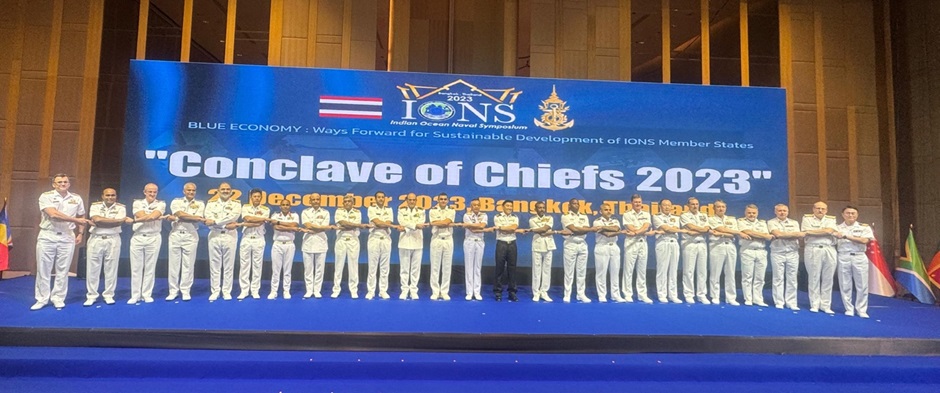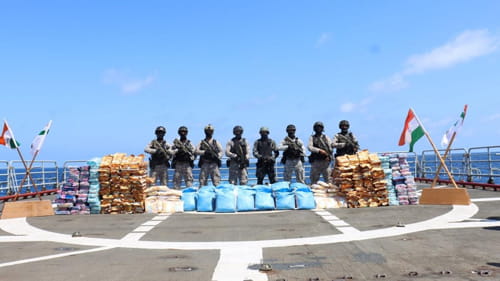
Indian and international naval officers at Indian Ocean Naval Symposium (IONS) Maritime Exercise 2023 (IMEX-23), Bangkok. | Indian Ministry of Defence.
Introduction
For a maritime nation like India, its conception of maritime security of the Indian Ocean Region (IOR) and specifically, its approach to maritime security has a long historical legacy.1 In 1946, KM Panikkar had stated that “Unless India is prepared to stand forth and shoulder the responsibility of peace and security in the Indian Ocean, her freedom will mean but little”, and that “India's future therefore is closely bound up with the strength she is able to develop gradually as a naval power.”2
The Cold War saw delineations in the IOR between the USA and the erstwhile Soviet Union, and the superpower rivalry placed India closer to the Soviet camp. The mistrust that flowed from the Cold War years limited India’s vision of regional maritime security while it sought avenues of détente with the IOR nations by building a position of stability and trust while negotiating to shed the tag of ‘regional hegemon’.3
Over time, several shibboleths were shed as India’s strategic outlook evolved and the aspect of India’s maritime security was perhaps guided by K Subrahmanyam’s argument that “diplomacy and military power are mutually reinforcing, not each other's substitute”.4
This approach led to the development of better relations with most of its neighbours and the regional IOR nations,with India being seen as a regional power and astable nation with no hegemonic interests. The emergence of an increased element of trust, better relations with the IOR nations, and cooperation at regional organisations saw an enhanced outreach by India using both soft and hard power to ensure stability, security and peace in the IOR’s maritime domain.
India’s Maritime Strategy
According to Norman Hartman, Foreign Policy is “a systematic statement of deliberately selected national interests.”5 India’s maritime security strategy – which is an important integral part of its foreign policy – took time to evolve for a variety of reasons. This evolution reflects a systematic approach wherein several elements of national power were used.
These consisted of a mix of the soft and hard power aspects, inter alia of diplomacy, economics, and military power. India’s growth as a rising economic power and recognition as a ‘Preferred Security Partner and First Responder’, and the spurt of strategic partnerships with many nations, has seen the evolution of a set of contemporary concepts and initiatives that are dealt withthe working groups of IOR regional organisations headed by a lead nation. India works mainly through these structures and frameworks with regional nations to address the non-traditional threats that impact the IOR.
Structures, Frameworks and Engagements
Over time maritime security evolved as an accepted global term covering Freedom of Navigation that resonated at the national, regional and global levels, and naval power metamorphosed into maritime power that enveloped both hard and soft power attributes. Post the Cold War and the emergence of new strategic alignments and strategic partnerships, maritime cooperation that started as a buzzword became a mantra.
In this new security environment, India’s contemporary approach to maritime security was placed under the broad umbrella of Security and Growth for All in the Region (SAGAR), a concept that can be replicated in any maritime region of the world. Under SAGAR, India’s maritime engagements within the IOR can be clubbed under several structures and frameworks like Indian Ocean Rim Association (IORA), Indian Ocean Naval Symposium (IONS), Neighbourhood First, Bay of Bengal Initiative for Multi-Sectoral Technical and Economic Cooperation (BIMSTEC), the Indo-Pacific Oceans Initiative (IPOI), and the Coalition for Disaster ResilientInfrastructure (CDRI), minilaterals, institutionalised maritime exercises and mission-based deployments.
The central focus of these engagements, which are based on inclusivity, is on non-traditional threats that threaten the stability, security and peace of the region. Further, central to these structures and frameworks, is a commonthread that seeks to address threats, challenges and risks arising from the maritime domain while maximising on the cooperative opportunities that arise as part of the addressal mechanism.
This inclusive approach was extended to India’s concept of the Indo-Pacific Region and amplified in India’s vision of a ‘free, open and inclusive’ Indo-Pacific. At the international level the importance of maritime security was highlighted by Prime Minister Modi during the first ever open maritime security debate, Enhancing Maritime Security – A Case for International Cooperation at the United Nations Security Council (UNSC) on 9 August 2021. The debate was held under India’s Presidency of the UNSC, and the following five basic principles were discussed which indicate the holistic manner of India’s approach to maritime security:6
1. Removal of barriers from legitimate maritime trade.
2. Peaceful settlement of disputes as per international law.
3. Joint addressal of natural disasters and maritime threats created by non-state actors.
4. Preservation of the marine environment and resources.
5. Encouragement of responsible maritime connectivity.

INS Talwar successfully apprehended a suspicious dhow in support of Combined Task Force 150-led focussed Operation Crimson Barracuda, recovering 940 kilograms of narcotics, March 2024. | Indian Navy.
Territorial instability always impacts the security and peace of the surrounding marineenvironment. Hence, stability is a major factor, as any reduction or loss of stability leads to an unsafe environment that harbours and supports non-state actors. These actors thrive on and drive non-traditional threats like maritime crimes, especially terrorism; piracy; the smuggling of guns, drugs and humans; and as seen more recently the new phenomena of attacks on merchant shipping in the Red Sea by the Houthis.
While the Houthi actions are a threat and challenge that is part/subset of an ongoing traditional conflict, it has added to the instability and also aided the resurgence of another non-traditional threat: piracy. The overarching impact of a combination of such non-traditional threats has far-reaching effects on a region and the nations within.
For example, the impact on India’s economy from November 2023 to 31 March 2024, due to the Houthi attacks, has been assessed as 30 billion USD.7 While India may be able to absorb this initial impact, the impact on smaller nations could be worse.
While actions to address the Houthi threat are dictated by the complex web of traditional state-on-state relations, the resurgence of piracy would need readdressing as done before. India’s addressal of piracy has been successful as proven by Indian Navy deployments, the earlier experience of dealing with pirates including effective use of kinetic means and cooperation with different navies brought about by increasing interoperability through capacity and capability building.
Capacity- and capability-building find resonance across all the regional organisations of the IORs, especially in maritime security, safety and disaster risk management. Hence, it also forms an important part of India’s maritime security strategy and is applied both domestically and as well as regionally. Regional efforts add to enhanced interoperability and therefore, better cooperative mechanisms.
Conclusion
In dealing with non-traditional threats, India’s maritime security strategy aims at strengthening three pillars: the promotion of stability; the maintenance of security and the preservation of peace. This approach has been mentioned in the third constituent strategy Shaping a Favourable and Positive Maritime Environment as outlined in the Indian Navy’s 2015 unclassified strategy document, Ensuring Secure Seas: Indian Maritime Security Strategy (IMSS 2015).8 The idea is to “to promote security and stability at sea, and enhance cooperation, mutual understanding and interoperability with maritime forces of friendly nations”, thereby shaping a suitable maritime environment beneficial for the IOR under the rubric of SAGAR.9
(Exclusive to NatStrat)
Endnotes: